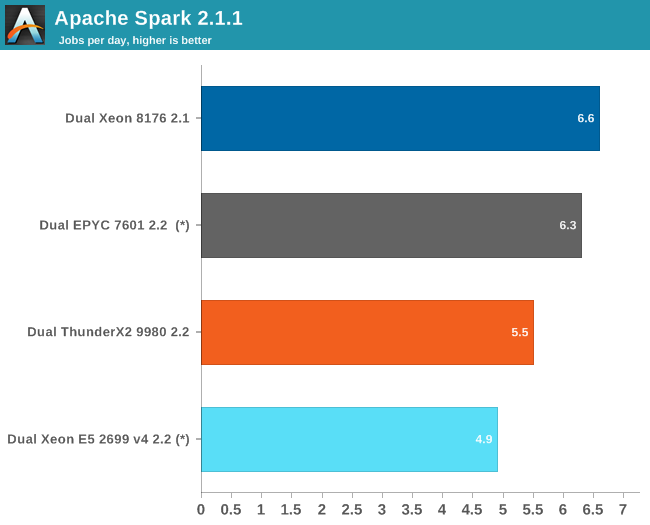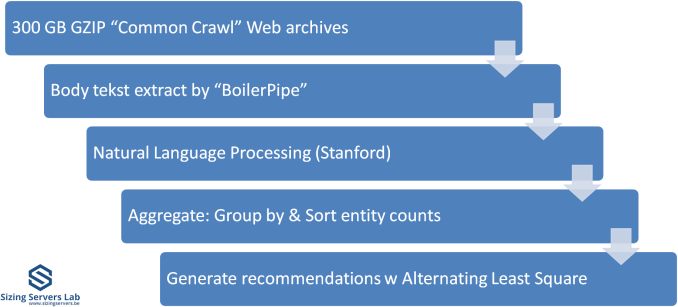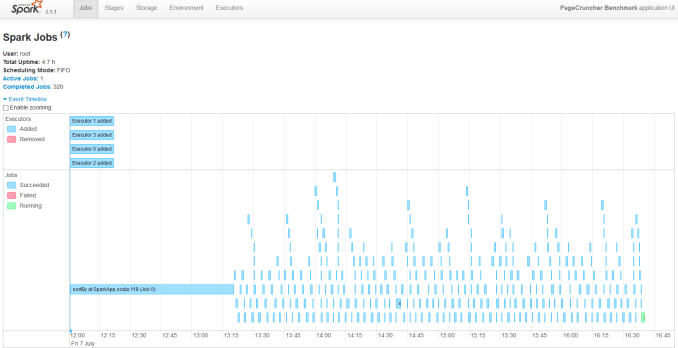Assessing Cavium's ThunderX2: The Arm Server Dream Realized At Last
by Johan De Gelas on May 23, 2018 9:00 AM EST- Posted in
- CPUs
- Arm
- Enterprise
- SoCs
- Enterprise CPUs
- ARMv8
- Cavium
- ThunderX
- ThunderX2
Apache Spark 2.x Benchmarking
Last, but not least, we have Apache Spark. Apache Spark is the poster child of Big Data processing. Speeding up Big Data applications is the top priority project at the university lab I work for (Sizing Servers Lab of the University College of West-Flanders), so we produced a benchmark that uses many of the Spark features and is based upon real world usage.
The test is described in the graph above. We first start with 300 GB of compressed data gathered from the CommonCrawl. These compressed files are a large amount of web archives. We decompress the data on the fly to avoid a long wait that is mostly storage related. We then extract the meaningful text data out of the archives by using the Java library "BoilerPipe". Using the Stanford CoreNLP Natural Language Processing Toolkit, we extract entities ("words that mean something") out of the text, and then count which URLs have the highest occurrence of these entities. The Alternating Least Square algorithm is then used to recommend which URLs are the most interesting for a certain subject.
To get better scaling, we run with 4 executors. Researcher Esli Heyvaert reconfigured the Spark benchmark so it could run on Apache Spark 2.1.1.
Here are the results:

(*) EPYC and Xeon E5 V4 are older results, run on Kernel 4.8 and a slightly older Java 1.8.0_131 instead of 1.8.0_161. Though we expect that the results would be very similar on kernel 4.13 and Java 1.8.0_161, as we did not see much difference on the Skylake Xeon between those two setups.
Data processing is very parallel and extremely CPU intensive, but the shuffle phases require a lot of memory interactions. The time spent on storage I/O is negligible. The ALS phase does not scale well over many threads, but is less than 4% of the total testing time.
The ThunderX2 delivers 87% of the performance of the twice as expensive EPYC 7601. Since this benchmark scales well with the number of cores, we can estimate that the Xeon 6148 will score around 4.8. So while the ThunderX2 can not really threaten the Xeon Platinum 8176, it gives the Gold 6148 and its ilk a run for their money.












97 Comments
View All Comments
Eris_Floralia - Wednesday, May 23, 2018 - link
The L2$ for SKX should be 1MB (256+768KiB), 16-way.Ryan Smith - Wednesday, May 23, 2018 - link
Right you are. Thanks!danjme - Wednesday, May 23, 2018 - link
Mental.Duncan Macdonald - Wednesday, May 23, 2018 - link
The CPU may be much cheaper than the equivalent Intel CPU - however on the price of a complete server there would be almost no difference as the vast majority of the price of a server is in other items (RAM, storage, network, software etc). To take a significant share, the performance needs to be better than Intel CPUs on both a per thread and a per socket basis. Potential users will look at this CPU - see that it is not faster than Intel on a per thread basis and is also not X86-64 compatible and turn away with a shrug. A price difference of under 5% for a complete server is not enough to justify the risks of going from x86-64 to ARM.BurntMyBacon - Thursday, May 24, 2018 - link
Perhaps you are correct and the lack of per thread performance will not allow Cavium to take a "significant' share of the market from Intel. However, at this point, getting even a small amount of market penetration in the server market is a significant achievement for an ARM vendor. This processor doesn't need to take a "significant" share from Intel to be successful. It just needs to establish a solid foothold. Given the data, I think it has a good chance of succeeding in that.The bigger question in my mind is how Intel will respond. They already have the ability to make a many lite core accelerator as demonstrated by the Xeon Phi line. Will they bring this tech to their CPU lineup, create a new accelerator based on this tech to handle applications that use many light threads, create a new many small core CPU based on Goldmont Plus (or Tremont), or will they consider the ARM threat insignificant enough to ignore.
boeush - Wednesday, May 23, 2018 - link
"(*) EPYC and Xeon E5 V4 are older results, run on Kernel 4.8 and a slightly older Java 1.8.0_131 instead of 1.8.0_161. Though we expect that the results would be very similar on kernel 4.13 and Java 1.8.0_161"What about Spectre/Meltdown mitigation patches? Were they in effect for 'older' results?
boeush - Wednesday, May 23, 2018 - link
To elaborate: if those numbers really are from July 2017, then they don't reflect true performance in a server context any longer (servers are where Spectre/Meltdown patches would be applied most.). Since the performance impact of Spectre/Meltdown is greatest on speculative execution and memory loads/prefetching, I'd guess those super-aggressive memory subsystem performance numbers, as well as single thread IPC advantages that Intel's CPUs claim in your benchmarks, are not really entirely applicable any longer.HStewart - Wednesday, May 23, 2018 - link
Spectre has been proved to effect other CPU's than Intel and even effects ARM and AMD.,Image on this article states that this CPU supports Fully Out of Order execution. So with my understanding of Spectre that this CPU also has issues.
To be honest I not sure how much the whole Spectre/Meltdown stuff is in this real world. It probably cause more harm in the computer industry than help.
Manch - Thursday, May 24, 2018 - link
Commentor: Blah Blah Blah Spectre?HStewart: Shill Shill Shill must defend Intel by any means...
lmcd - Thursday, May 24, 2018 - link
Commentor: reasonable position takenManch: *banned for unreasonable, offensive comments*